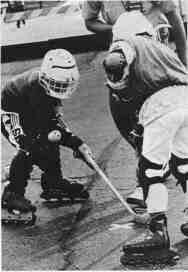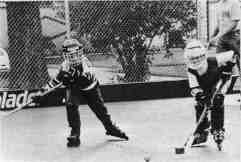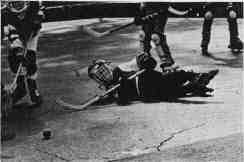 |
Home | Search | Browse | About IPO | Staff | Links |
 |
Home | Search | Browse | About IPO | Staff | Links |
|
Illinois Parks & Recreation May/June 1995 • Volume 26, Number 3 Inline Roller Hockey
The Gameof the 1990s 
Matt Gimms and Anthony Brancato face-off during an inline roller hockey game in LaGrange. by John P. Hecker Currently about two million people In the United States play roller hockey. The National Inline Hockey Association expects that number to reach 4 million In 1096. The National Sporting Goods Association ranks It as one of the top ten sports among 12 to 17 year olds. If tennis was the sport of the 1970s, then maybe inline hockey is the game of the 1990s. Trying to stay in touch with the times, the Community Park District of LaGrange Park offered an inline hockey program during the fall of 1993 after receiving requests from residents to "get the kids off the streets." Inline roller hockey, as it is played in LaGrange Park is very similar to regular ice hockey. The major difference is that it is played on "inline skates." (Many folks refer to them as Rollerblades; however, that is a trade name.) The park district held an informational meeting prior to organizing the program in an effort to better gauge interest as well as to recruit volunteers to act as coaches and helpers. At this meeting a demonstration of skating and hockey skills was conducted by several members from the community. Approximately 50 people attended the first meeting with 12 volunteers signing up to help. The park district contacted several schools, businesses and churches in an effort to secure a suitable parking lot or asphalt play lot to host the program. The park district itself had no suitable surface available at that time. After convincing the local school district that our insurance carrier, Park District Risk Management Agency (PDRMA), would cover the program, the park district began the fall 1993 program on an asphalt playground. The portable rink system "Border Patrol" was purchased for $4, 200 and was transported each Saturday to the site (setup time took 45 minutes for one person). One hundred thirty-five (135) children played for the first eight-week program. Illinois Parks & Recreation ¦ May/June 1995 ¦ 25 
Dan Donovan of West Springs and Joshua Wohl ofLaGrange Highlands each play for a team consisting of 12 members. Players rotate every two minutes with a stoppage in play. 
Players are required to wear complete protective equipment including helmet with cage, hockey gloves, elbow pads, shinguards, protective cup and mouthguard.
Age groups were divided into the following categories:
Over half of the boys and girls in the program were from LaGrange Park. The surrounding communities fed into the program because no other villages offered the activity at that time. Players are required to wear complete protective equipment including helmet with cage, hockey gloves, elbow pads, shinguards, protective cup and mouthguard. Each team is made up of 12 players, and players rotate every two minutes with a stoppage in play. For the two younger divisions, teams play four against four plus the goalie, while the older players play three on three plus the goaltender. Prior to each scheduled game, teams are allowed twenty-five minutes of practice time to warm-up and go over drills.
FUN AND SKILL
DEVELOPMENT STRESSED
NEED FOR A PERMANENT SITE The "Border Patrol" rink system was placed around the perimeter of both rinks at the base of the fencing. Although the optimum size rink is considered to be 165' x 65', our rink surfaces measure only 110' x 55'. This small size rink has added to the excitement of the game, creating constant action around the goals.
OBJECTIONS FROM
TENNIS ASSOCIATION The park board had some tough decisions ahead, but decided to resurface the facility with a "road mix" asphalt which is harder than the traditional tennis court surfacing. This would allow for skating and hockey play without concern for grooving and scratching. The color coat system would not be added until a later date. One of the most important factors in this park district decision was the unknown. No one knows how long this activity will be "hot." Why build a special facility when an existing facility is available and not being used—especially when we have a community that is landlocked, and every piece of space is spoken for! 26 ¦ Illinois Parks & Recreation ¦ May/June 1995
SAFETY
FINANCIALLY SELF-SUPPORTING Entering into the fourth season, the park district is well into the "black," with enough reserves to set aside for future improvements to the facility.
THE FUTURE OF THE PROGRAM In the years ahead, ice hockey will see the impact that inline hockey will have on that sport. The fundamentals are the same and will only help to prepare the young skaters for the transition to ice. A recent example of this occurred when several inline players from LaGrange Park joined a house league ice hockey program this past fall. The league organizer made special mention that the teams had to bedivided up so that "all of the kids from LaGrange Park are not on the same team." During the past several months, the Community Park District of LaGrange Park has sent out over 50 packets of information to interested communities related to forming a program. Further information is available by calling the park district office, (708) 354-4580 John P. Hecker is the Director of Parks and Recreation for the Community Park District of LaGrange Park. LaGrange Park, a community of 13, 000 residents, is located in Western Cook County, 11 miles due west of Chicago. Illinois Parks & Recreation* May/June 1995 ¦ 27 |
|
Sam S. Manivong, Illinois Periodicals Online Coordinator |